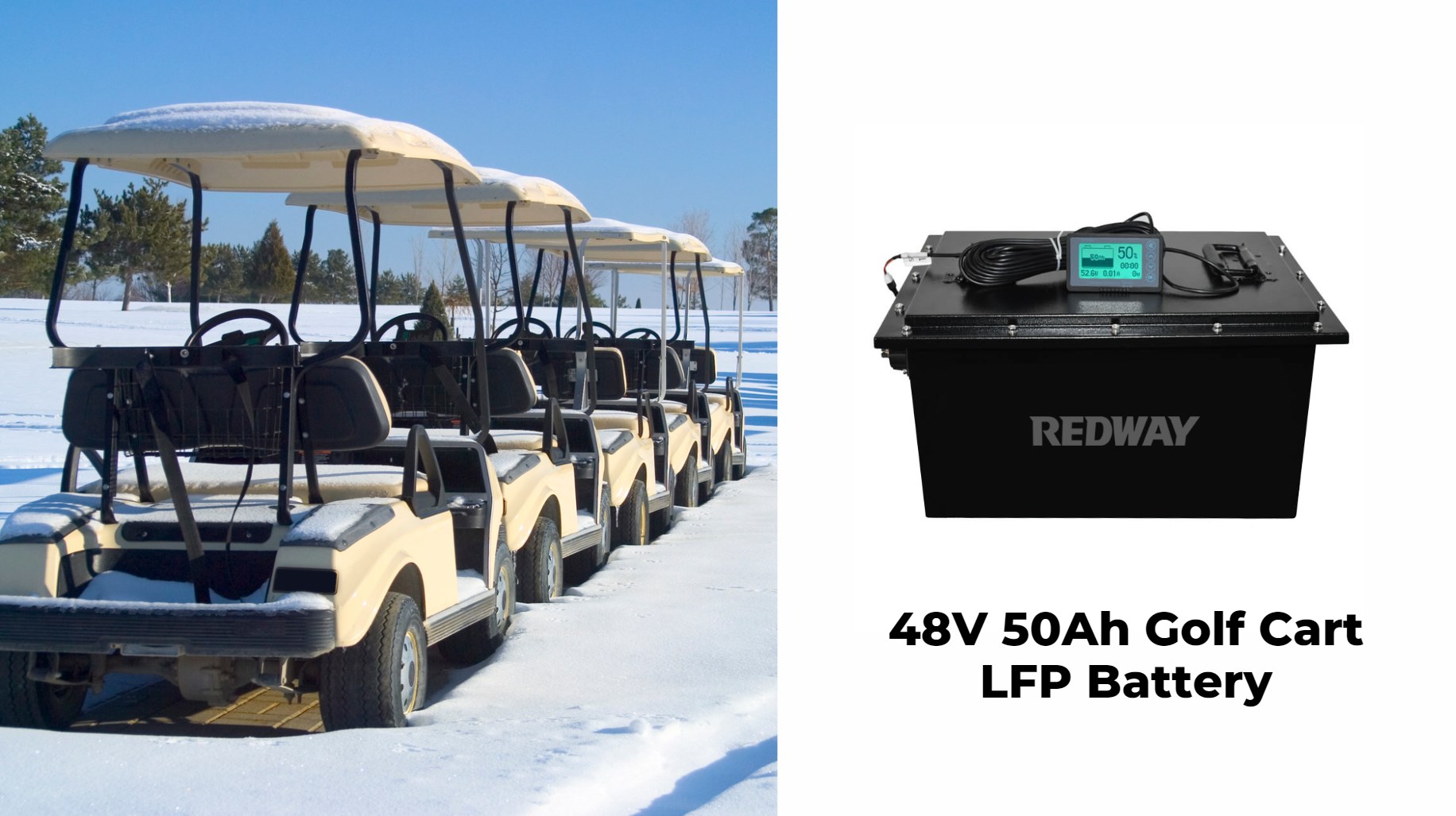How Do LiFePO4 Batteries Perform in Cold Weather?
As the popularity of electric vehicles, including golf carts, continues to rise, understanding the performance of different battery technologies in various environmental conditions becomes essential. Lithium Iron Phosphate (LiFePO4) batteries are a popular choice for many applications, particularly in golf carts, due to their reliability, safety, and longevity. However, their performance in cold weather conditions can vary significantly compared to traditional lead-acid batteries. At Redway Battery, we have specialized in manufacturing LiFePO4 batteries for over 12 years, focusing on delivering quality solutions for golf carts and other applications. This article will explore how LiFePO4 batteries perform in cold weather and what users should consider for optimal performance.
LiFePO4 batteries work better in cold weather than many other types but can still lose capacity at temperatures below -20°C. Charging them in freezing conditions can damage the battery. To ensure optimal performance, avoid charging when it’s too cold and keep them insulated when possible.
1. Overview of LiFePO4 Battery Technology
LiFePO4 batteries are known for their superior thermal stability, long cycle life, and safety features. Unlike traditional lithium-ion batteries, LiFePO4 batteries use iron phosphate as the cathode material, which provides several advantages:
- Increased Safety: LiFePO4 batteries are less prone to thermal runaway, making them safer for use in various applications.
- Longer Lifespan: These batteries typically have a cycle life of 2,000 to 5,000 cycles, significantly outlasting conventional lead-acid batteries.
Despite these advantages, cold weather can still impact the performance of LiFePO4 batteries.
2. Impact of Cold Temperatures on Battery Performance
Cold weather can adversely affect battery performance in several ways:
Reduced Capacity
As temperatures drop, the chemical reactions within a LiFePO4 battery slow down, leading to reduced capacity. In frigid conditions, users may experience a significant decrease in the effective capacity of their batteries. For example, at 0°C (32°F), a LiFePO4 battery might deliver only 60-80% of its rated capacity. This means that a 100Ah battery may only provide 60-80Ah of usable power, which can impact the range and functionality of electric golf carts.
Increased Internal Resistance
Low temperatures also increase the internal resistance of LiFePO4 batteries, which can lead to:
- Lower Voltage Output: As resistance increases, the voltage output of the battery can drop, resulting in decreased power availability for the cart’s motor.
- Reduced Efficiency: Higher internal resistance leads to more energy loss as heat, further reducing the overall efficiency of the battery system.
Slower Charging Rates
Charging LiFePO4 batteries in cold weather can be problematic. When temperatures drop below 0°C (32°F), the charging process becomes less efficient, and batteries can enter a state of lithium plating. This condition can cause irreversible damage and significantly reduce the battery’s lifespan. To mitigate this, it is essential to:
- Use Battery Management Systems (BMS): Advanced BMS can monitor temperatures and manage charging rates accordingly to prevent damage during cold conditions.
- Preheat Batteries: Some users opt to preheat their batteries using external heating solutions before charging, ensuring that they operate within optimal temperature ranges.
3. Strategies for Maintaining LiFePO4 Battery Performance in Cold Weather
To ensure that your LiFePO4 batteries perform optimally in cold weather, we recommend implementing the following strategies:
1. Insulation
Using thermal insulation can help protect the battery from extreme cold. Insulated battery boxes can maintain higher temperatures, thus minimizing the negative impact of low temperatures on performance. Insulation materials such as foam or specialized battery blankets can be effective.
2. Keep Batteries Charged
Maintaining a full charge can help reduce the effects of cold weather. Fully charged LiFePO4 batteries are less susceptible to capacity loss and voltage drops in colder temperatures. It is advisable to charge the batteries regularly, particularly before storage in cold environments.
3. Monitor Temperature
Utilizing temperature monitoring systems allows users to keep an eye on the battery’s operational conditions. This helps in making timely decisions regarding charging and usage, ensuring the battery remains in optimal condition.
4. Avoid Deep Discharges
Deep discharging can further exacerbate the issues associated with cold weather. To preserve battery health, we recommend avoiding discharges below 20% of the total capacity, especially during colder months.
4. Real-World Performance of LiFePO4 Batteries in Cold Weather
Real-world tests have demonstrated that while LiFePO4 batteries experience performance degradation in cold weather, they still outperform traditional lead-acid batteries in many scenarios. For instance:
- Faster Recovery: When temperatures rise, LiFePO4 batteries tend to recover their capacity much quicker than lead-acid batteries, which can remain impaired for longer periods.
- Efficiency: In moderate cold conditions (down to about -10°C / 14°F), LiFePO4 batteries still provide sufficient performance for golf carts, making them suitable for various outdoor activities, including winter golf.
5. Conclusion
LiFePO4 batteries offer numerous benefits, including longevity, safety, and efficiency, but they do face challenges in cold weather. By understanding these challenges and implementing strategies to mitigate their effects, users can maximize the performance of their LiFePO4 batteries, even in colder climates. At Redway Battery, we are committed to providing high-quality LiFePO4 batteries and solutions for golf carts, ensuring that our customers can enjoy reliable power year-round. For tailored solutions and quick quotes, contact us today!
Latest News
- Cold Performance Studies: Recent research indicates that while LiFePO4 batteries perform better than traditional lead-acid options in cold weather, their capacity may still be affected by low temperatures.
- User Experiences: Users report varied performance levels depending on specific environmental conditions during usage.
- Industry Recommendations: Experts suggest using thermal insulation or heating elements to mitigate cold weather impacts on battery performance.
Redway Expert Comment
LiFePO4 batteries generally outperform lead-acid counterparts in cold weather; however, they are not immune to capacity loss due to low temperatures. Implementing thermal insulation or heating elements can significantly mitigate these effects, ensuring consistent performance even in challenging conditions. As an expert, I encourage users operating in colder climates to adopt these strategies for optimal battery function.
FAQs
What are the best methods to insulate LiFePO4 batteries in cold weather?
To effectively insulate LiFePO4 batteries in cold weather, consider using thermal blankets or insulation wraps specifically designed for battery protection. Placing the batteries in a heated enclosure or using foam board insulation can also help maintain warmth. Additionally, maintaining a stable ambient temperature and using battery heaters can prevent performance issues.How does cold weather affect the lifespan of LiFePO4 batteries?
Cold weather can reduce the efficiency and usable capacity of LiFePO4 batteries, leading to diminished performance. While they are more resilient than other battery types, prolonged exposure to extreme cold can still negatively impact their lifespan by increasing internal resistance and slowing down chemical reactions.Are there any specific brands of LiFePO4 batteries that perform better in cold conditions?
Brands like RELiON and Battle Born are known for their performance in cold conditions. The RELiON LT Series, for example, can operate and charge at temperatures as low as -4°F (-20°C) without significant performance degradation, making them suitable for colder climates.What are the risks of using LiFePO4 batteries in extremely cold temperatures?
Using LiFePO4 batteries in extremely cold temperatures poses risks such as reduced capacity, increased internal resistance, and potential lithium plating during charging. Charging below freezing can lead to irreversible damage, reduced efficiency, and even safety hazards if not managed properly.How effective are battery heaters in improving LiFePO4 performance in cold weather?
Battery heaters are highly effective in improving LiFePO4 performance in cold weather. They help maintain optimal operating temperatures, enhancing charge acceptance and overall efficiency. By preventing the electrolyte from becoming too viscous, heaters ensure better ion transfer and reduce the risk of damage during charging.



